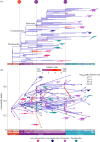Locomotion and the early Mesozoic success of Archosauromorpha
- PMID: 38328568
- PMCID: PMC10846959
- DOI: 10.1098/rsos.231495
Locomotion and the early Mesozoic success of Archosauromorpha
Abstract
The Triassic was a time of ecological upheaval as life recovered from the Permian-Triassic mass extinction. Archosauromorphs were a key component of the recovery, diversifying substantially during the Triassic and encompassing the origins of dinosaurs, pterosaurs and crocodylomorphs. Here, we explore the evolution of locomotion in Archosauromorpha to test whether dinosaurs show any distinctive locomotory features that might explain their success. We implement geometric morphometrics on limb bone shapes and use limb ratios to calculate bipedality and cursoriality metrics. We find that the Avemetatarsalia (dinosaurs, pterosaurs and relatives) exhibit more variable limb form and limb ratios than any other group, indicating a wider range of locomotory modes. The earliest avemetatarsalians were bipedal and cursorial, and their range of form increased through the Triassic with notable diversification shifts following extinction events. This is especially true of dinosaurs, even though these changes cannot be discriminated from a stochastic process. By contrast, the Pseudosuchia (crocodilians and relatives) were more restricted in limb form and locomotor mode with disparity decreasing through time, suggesting more limited locomotor adaptation and vulnerability to extinction. Perhaps the greater locomotor plasticity of dinosaurs gave them a competitive advantage in the changing climates of the Late Triassic.
Keywords: archosauromorphs; archosaurs; avemetatarsalians; dinosaurs; diversity; pseudosuchians.
© 2024 The Authors.
Conflict of interest statement
We declare we have no competing interests.
Figures








References
-
- Weishampel DB, Dodson P, Osmólska H. 2004. The dinosauria. pp. 833. Berkeley, CA: University of California Press.
-
- Benson RB, Hunt G, Carrano MT, Campione NE. 2018. Cope's rule and the adaptive landscape of dinosaur body size evolution. Palaeontology 61, 13-48. (10.1111/pala.12329) - DOI
Associated data
LinkOut - more resources
Full Text Sources

